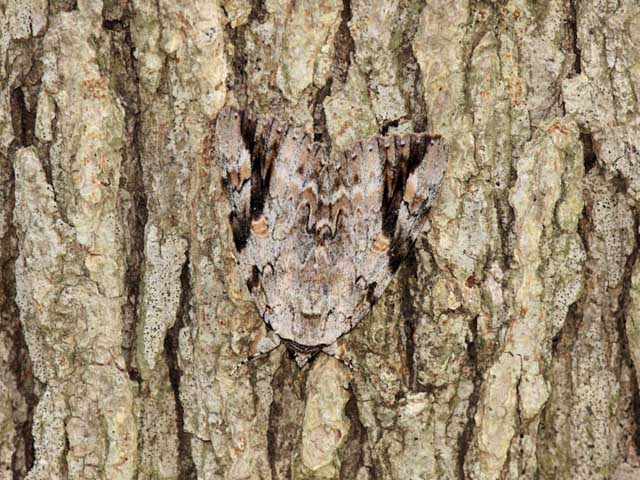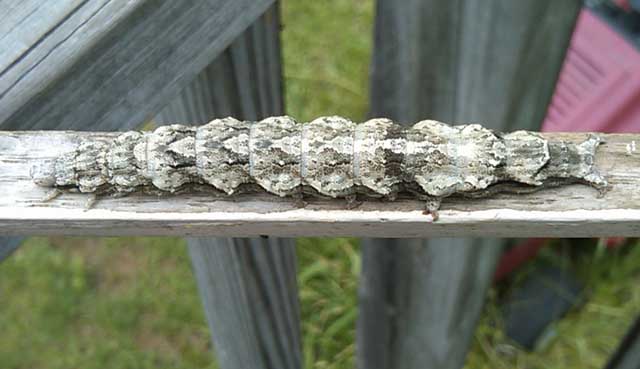Catocala maestosa
Catocala maestosa
kah-TOCK-uh-lah mm
mee-STOH-suh
Hulst, 1884

Catocala maestosa male
courtesy of Vernon A. Brou.
This site has been created by
Bill Oehlke at oehlkew@islandtelecom.com
Comments, suggestions and/or additional information are welcomed by Bill.
| TAXONOMY:
Superfamily: Noctuoidea
Family: Noctuidae
Group: Noctuinina
Subfamily: Catocalinae
Genus: Catocala, Schrank, 1802
| |
MIDI MUSIC
"Moon River"
copyright C. Odenkirk
MIDI CITYON.OFF
<bgsound src="moon.mid" LOOP=FOREVER>
|
DISTRIBUTION:
Catocala maestosa, the Sad
Underwing (wingspan: 78-98mm), flies from
New York south to
Florida and Alabama,
west to
Texas and eastern Oklahoma and north
to
Illinois,
Indiana and Minnesota.
It has also been reported in
Arkansas,
Georgia,
Iowa,
Kansas,
Kentucky,
Louisiana,
Maryland,
Minnesota,
Mississippi,
Missouri,
Nebraska,
New Jersey,
North Carolina,
North Dakota,
Ohio,
Oklahoma,
Pennsylvania,
South Carolina,
Tennessee,
Virginia and
Wisconsin.
Maestosa is quite similar to, although usually larger than,
vidua. Both have the dark arc from the costa, above
the reniform spot, to the outer margin just below the apex.
Maesotsa,
however, lacks the dark bar, found on vidua, parallel to the
inner margin. The reniform spot is brown and there is brown
shading just outside the postmedial line.
The hindwing fringe is white, narrow and heavily barred. |

Image courtesy of Charles S. Lewallen |

Catocala maestosa, Central Park, New York, courtesy of Marie Winn.
FLIGHT TIMES AND PREFERRED FOOD PLANTS:
Catocala maestosa are usually on the wing from July to
October.
In Mississippi this moth has been taken from April to November,
probably as a single brood with a very haphazard emergence pattern.
The Catocala maestosa caterpillar feeds on hickories, pecans and walnuts.

Catocala maestosa on Bur Oak, Leon River, Coryell County, Texas,
August 5, 2009, courtesy of Eric Runfeldt.
Eric Runfeldt observes, "Yesterday, 05 Aug, I came across another large grouping, (more than 30), of these same moths in the river bottom of the same lake but at the
other end. Approx. 25 miles from the first group.
This time I had a better idea what to look for and although I could not get photos of the open wings I did see the black under wings with the white outline.
"So far all of my sightings have been in Bell county, Texas on the creeks/river bottom of Belton Lake.
"I noticed yesterday that not long after landing these fold their antennae along their wingline."
Eric added on the following day, "After looking around I noticed that although Pecan trees, (Carya illinoinensis), were scattered among the trees, the major
number of Sad Wing's were resting on Bur Oaks, (Quercus macrocarpa), and some were resting on Cottonwood trees, (Populus deltoides).
"I did not see any on Elm, (Ulmus rubra), or Sugarberry, (Celtis laevigata), trees also in the area, they would fly right by any tree less than 24in.
in diameter. A few were resting 5-7ft from the ground, some were within 6 inches of the ground and I saw none over 8ft. Even after being flushed they returned to
less than 6ft, I don't believe I was ever allowed within 3ft before they flushed. Almost all were hanging nose down and returned to that postion after flushing and
landing. Most were on the shade side of the tree, a few on the brighter side, but none in full sun."
ECLOSION:
Adults eclose from pupae at soil surface.
Visit Catocala maestosa, Northampton County, Pennsylvania, September 24, 2011, courtesy of
Stephen Kloiber via Curt Lehman, BAMONA rep.
SCENTING AND MATING:
Catocala maestosa females
emit an airbourne pheromone and males use their antennae to track the
scent plume.
EGGS, CATERPILLARS, COCOONS AND PUPAE:
Eggs are deposited on
tree bark in the fall and hatch the following spring.

Catocala maestosa larva, New Braunfels, Texas, May 31, 2007,
courtesy of Jason Fowler, tentative id by Larry Gall.
Of the larval image above, Dr.Gall indicates it is most likely
Catocala maestosa (most likely) or Catocala neogama.
Tammy Mauldin of Jefferson County, Alabama, sent the following image for identification. She found it under a pecan tree, indicating a length between 2.5 and 3 inches.

Catocala maestosa, Jefferson County, Alabama, May 2009, courtesy of Tammy Mauldin.
Larval Food Plants
Listed below are primary food plant(s) and alternate food plants.
It is hoped that this alphabetical listing followed by the common
name of the foodplant will prove useful. The list is not exhaustive,
although some species seem very host specific.
Experimenting with closely related foodplants is worthwhile.
Carya aquatica
Carya illinoinensis.....
Juglans nigra
|
Water hickory
Pecan
Black walnut
|
Return to Main Index
This page is brought to you by
Bill Oehlke and the
WLSS. Pages are on space rented from Bizland. If you would like
to become a "Patron of the Sphingidae/Catocala Sites",
contact Bill.
Please send sightings/images to Bill. I will do my best to respond to
requests for identification help.
Enjoy some of nature's wonderments, giant silk moth cocoons.
These cocoons are for sale winter and fall. Beautiful Saturniidae moths will emerge the following spring and summer.
Read Actias luna rearing article.
Additional online help available.
Eggs of many North American species are offered during the spring and summer. Occasionally
summer Actias luna and summer Antheraea polyphemus cocoons are available. Shipping to US destinations is done
from with in the US.
Use your browser "Back" button to return to the previous page.

Click on the flashing butterfly to show
appreciation for this site
and to visit other insect related
sites. |

|







